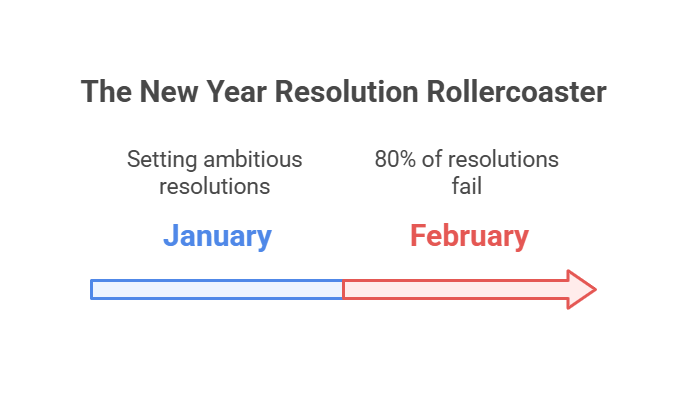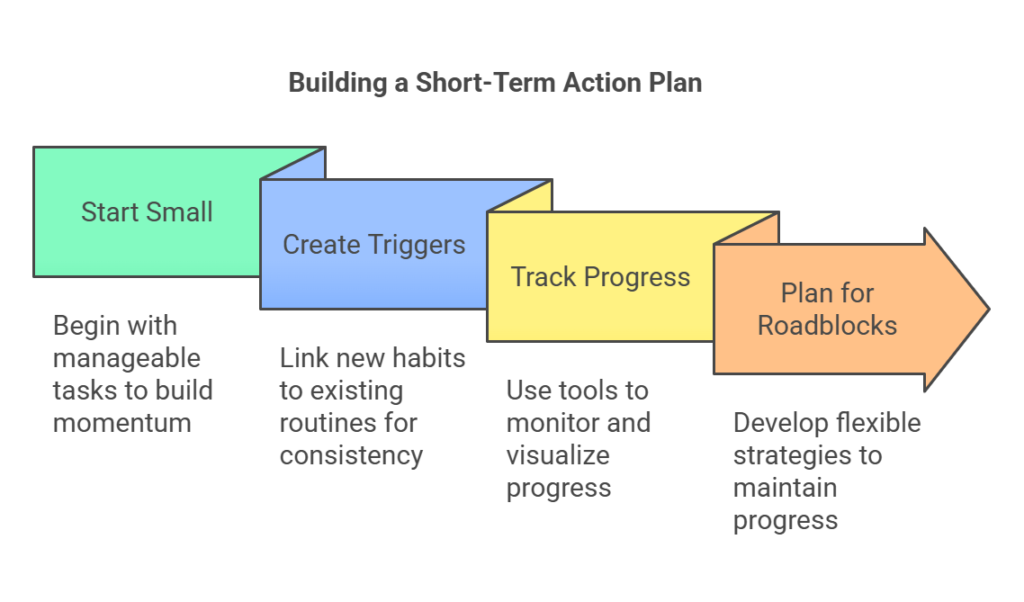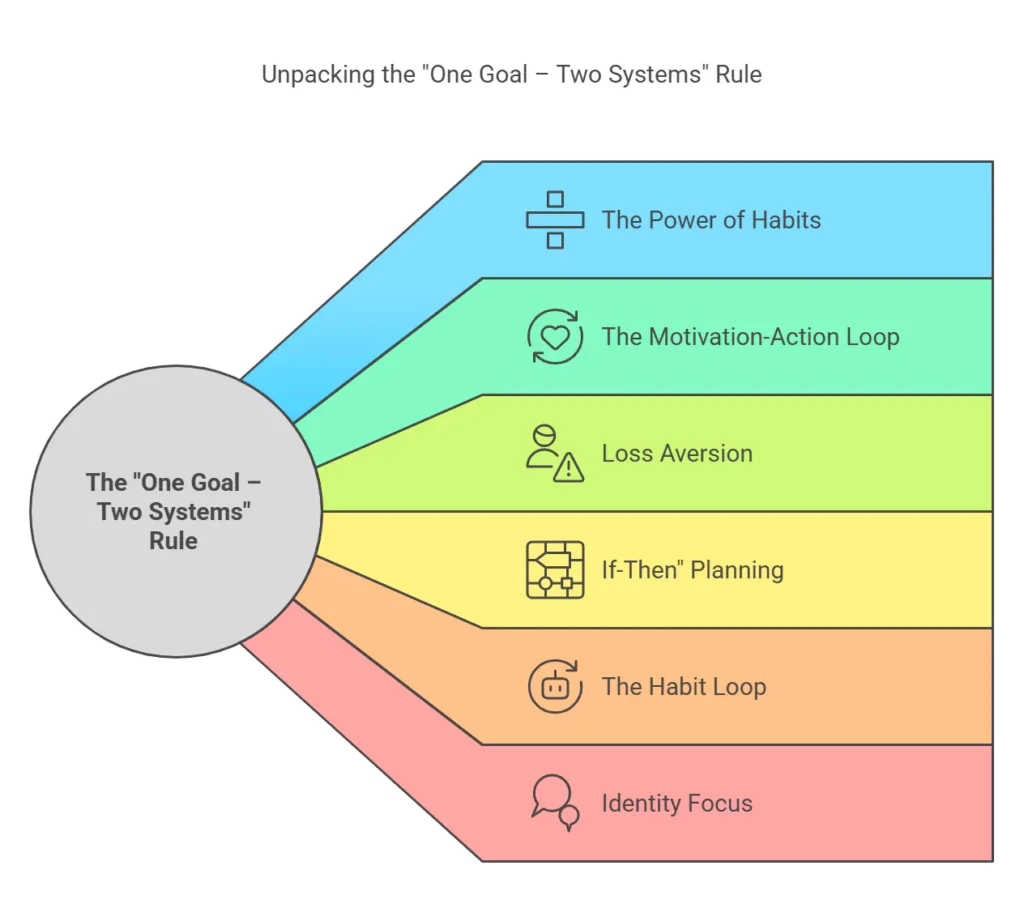Every January, millions of us set ambitious New Year’s resolutions, hoping this will be the year we finally get it together. Whether it’s losing weight, saving money, or learning a new skill, we dive in with enthusiasm. But let’s be honest—by February, most of us have already fallen off the wagon. Sound familiar? You’re not alone. Studies show that roughly 80% of New Year’s resolutions fail by the second month. That’s a tough pill to swallow, but it doesn’t have to be your story.

Enter the “One Goal-Two Systems” rule. This approach, crafted by psychologists, could be your golden ticket to making resolutions stick. It’s practical, effective, and backed by science—and the best part? It’s simple enough for anyone to try. So grab a coffee (or tea, no judgment here), and let’s dive into how this works and why it’s such a game-changer.
Why Resolutions Fail: The Missing Link
Before we get into the nitty-gritty of the “One Goal-Two Systems” rule, let’s talk about why resolutions tend to crash and burn. Most of us approach them like we’re sprinting a marathon—all effort upfront, no sustainable plan to keep going. Here are a few common traps:
- Overloading Yourself: Setting too many goals at once is a recipe for burnout. It’s like trying to juggle flaming torches before you’ve even mastered tennis balls.
- All-or-Nothing Thinking: One slip-up, and we’re ready to throw in the towel. Missed one workout? Might as well skip the whole week, right?
- Focusing Only on Outcomes: We fixate on results (like losing 20 pounds) instead of the habits and systems that actually get us there.
This is where the “One Goal-Two Systems” rule comes into play. It’s designed to help you avoid these pitfalls by creating a structure that supports your success.
The “One Goal-Two Systems” Rule: What Is It?
At its core, this rule is about balancing motivation with strategy. It’s built on the idea that achieving big goals requires two complementary systems:

- A Long-Term Vision System (your “why”): This is what keeps you grounded and focused over time. It’s all about creating steady habits—those small, consistent actions you do every day or week that slowly but surely move you toward your goal. Think of it like setting your car on cruise control—it keeps you moving without needing to think about it too much.
- A Short-Term Action System (your “how”): This is your spark plug. It’s designed to give you quick wins and a little momentum boost when you need it. It’s what keeps you motivated on the days when your long-term vision feels far away.
It’s kind of like driving a car. Your long-term vision is your destination—that big dream you’re aiming for. The short-term action system? That’s your GPS, giving you turn-by-turn directions. Without both, you’d either be wandering aimlessly or stuck in park.
The magic happens when you get these two systems working together. So, let’s dive into how you can make that happen.
Step 1: Define Your One Big Goal
Here’s the deal—step one is super simple: choose one main goal. Yep, just one. I know, it’s tempting to make a whole laundry list of resolutions (new year, new me vibes, right?), but hear me out. Research shows that when you focus on just one priority, you’re way more likely to actually pull it off.
In fact, a study from the University of Scranton found that people who locked in on a single, clear goal were 42% more likely to succeed compared to those trying to juggle a bunch of different objectives. Why? Because when you spread your energy too thin, nothing gets done. It’s like trying to boil the ocean—it’s just not happening.

How to Pick Your Goal
Ask yourself, What’s one thing that would really make my life better if I achieved it? Then make sure it ticks these boxes:
- Be Specific: Vague goals like, “I want to get healthy,” don’t cut it. Instead, say, “I’m going to exercise for 30 minutes, five days a week.” Clarity is key.
- Be Realistic (but not boring): Set the bar high enough to feel inspiring, but not so high that it’s laughable. You want to challenge yourself, but you don’t want to set yourself up for failure either.
Example Goals
- Lose 15 pounds in six months.
- Save $5,000 by the end of the year.
- Learn conversational French by December (bonjour, baguettes, and all that).
Got your goal locked in? Awesome! Now let’s move on to the good stuff—how to actually make it happen.ve on.
Step 2: Build Two Systems to Support Your Goal
Alright, you’ve got your goal—awesome! But now comes the part where the magic really happens: setting up the systems to back it up. Goals are great, but systems? They’re the secret sauce that keeps you moving forward, even on those “I-don’t-feel-like-it” days. Let’s break it down.
System 1: The Long-Term Vision
This is your big-picture, “why-am-I-doing-this” system. It’s what keeps your eyes on the prize and reminds you why this goal matters in the first place. Think of it like your personal pep talk on repeat.

How to Build Your Vision System:
- Picture Your Success: Close your eyes (or don’t, that’s up to you) and imagine what it’ll feel like when you crush this goal. What will your life look like? How will it feel? Write it down or slap some visuals on a vision board. Seeing it regularly keeps the excitement alive.
- Find Your “Why”: Ask yourself, Why does this goal matter to me? Dig deep. If your goal is to lose weight, is it about being healthier, feeling confident, or being able to keep up with your kids at the park? Knowing your “why” makes it personal and keeps you grounded.
- Break It Down: Big goals can feel overwhelming, so chop them into bite-sized pieces. For example, if your goal is to save $5,000, aim to save $1,250 every three months. Hitting these smaller milestones gives you that “heck yeah, I’m doing it!” feeling.
Example: Let’s say your goal is to save $5,000. Your long-term vision system might include:
- Visualizing a debt-free life (imagine the relief—no more dodging bills or worrying about your bank account).
- Remembering your “why”—maybe it’s buying a house or taking that dream vacation you’ve been fantasizing about.
- Breaking it into quarterly goals, like saving $1,250 every three months.
This system keeps your goal front and center, so even when the grind gets tough, you’ll remember what you’re working toward.
System 2: The Short-Term Action Plan
Now, while your long-term vision system keeps you pumped, this is the system that actually gets stuff done. It’s your day-to-day action plan—the small steps and habits that make progress happen on autopilot.

How to Build Your Action System:
- Start Small: Don’t go all-in right away. Start with something bite-sized and manageable. If your goal is to run a marathon, don’t sprint into a 10-mile run on Day 1. Start with running a mile three times a week. Small wins build momentum, and you’re less likely to burn out.
- Create Triggers: Link your new habit to something you already do. For example, if you want to exercise every day, tie it to brushing your teeth: “After I brush my teeth, I’ll do 10 minutes of yoga.” It’s like piggybacking on an existing routine.
- Track Your Progress: There’s something oddly satisfying about ticking off a box or seeing a streak on an app. Whether it’s a journal, a checklist, or an app, find a way to track your daily actions. Seeing progress makes you want to keep going.
- Plan for Roadblocks: Life happens. You’ll have days when you don’t feel like sticking to your plan—and that’s okay. The trick is to have a backup plan. If you miss a run, commit to walking instead. If you skip a language lesson, listen to a podcast in French on your commute. Flexibility keeps you in the game.
Step 3: Combine Systems to Build Momentum
Alright, here’s where it gets good—when you put your long-term vision and short-term action systems together, they start working like a dream team. Your vision system keeps your eyes on the prize, and your action system makes sure you’re chipping away at your goal one step at a time. Together? They’re unstoppable.
Let’s go back to the $5,000 savings goal. Here’s how these systems tag-team to get the job done:
- Vision System: You’re totally pumped about the idea of strolling through Paris, debt-free. You’ve even got a vision board with pictures of the Eiffel Tower, croissants, and cute cobblestone streets.
- Action System: You set up an automatic transfer of $200 from each paycheck into a savings account and check your balance every Friday to see how close you’re getting.
Here’s the magic: every time you see that savings account grow, it reminds you of why you’re doing this in the first place. Each little step you take keeps you motivated and makes the big picture feel real. It’s like building a snowball—momentum just keeps growing.
Addressing Common Concerns
“What if I fall off the wagon?”
First off, give yourself some grace. Slipping up doesn’t mean you’ve failed—it’s just a detour. Psychologists suggest focusing on process goals rather than outcome goals. For example, instead of saying, “I need to lose 20 pounds,” say, “I’ll walk for 20 minutes every day.” You can always get back on track by returning to the process.
“What if I lose motivation?”
That’s exactly why you need two systems! The short-term system gives you little boosts when motivation is low, and the long-term system ensures you’re still making progress even when you’re not feeling super inspired.
“What if I don’t see results fast enough?”
It’s normal to want instant results (we’re all human), but remember: change takes time. Focus on the small wins. Celebrate the fact that you showed up, even if the scale or bank account doesn’t budge immediately. Progress, no matter how tiny, is still progress.
Remember, progress isn’t about being perfect—it’s about being consistent over time.
Why This Works: The Psychology Behind It
Alright, let’s break down why the “One Goal – Two Systems” rule is such a game-changer. This isn’t just some motivational mumbo jumbo—it’s rooted in real psychology. Once you get it, it’s like, “Oh, that makes total sense!”

The Power of Habits
Let’s be real—habits don’t get nearly enough credit. They’re the behind-the-scenes players that quietly keep everything running. When you focus on long-term systems, you’re building habits that stick like Velcro.
BJ Fogg, the guy who wrote Tiny Habits, explains it best: small, consistent actions are where the magic happens. The trick? Keep it simple, make it something you actually enjoy, and tie it to stuff you’re already doing.
Want to read more? Pair it with your morning coffee—read for 5 minutes while you sip. Before you know it, it’s second nature. You’re not even thinking about it—it’s just what you do. Pretty sweet, right?
The Motivation-Action Loop
Let’s talk about motivation for a sec. Some days, you’re fired up and ready to crush it. Other days, you’d rather binge Netflix and eat chips. That’s why short-term systems are clutch.
Here’s how it works: when you knock out a small goal, your brain’s like, “Nice job, champ!” and hits you with a little dopamine boost. It’s like a high-five from your brain, and it makes you want to keep going.
Think about it—if you’re trying to get into a workout groove, completing a 30-day yoga challenge feels amazing. Those little wins? They’re the fuel that keeps the engine running.
Loss Aversion Is Real
Here’s a weird fact about humans: we hate losing way more than we like winning. Psychologists call it loss aversion, and it’s why having two systems works so well.
If one system slips—like skipping a morning workout—the other one (like a short-term challenge) gives you a safety net. It’s like your brain saying, “Relax, we’re still making progress.” That little backup plan keeps you from throwing in the towel completely.
“If-Then” Planning for the Win
This one’s a fancy way of saying you need a backup plan for when life inevitably throws a wrench in your schedule. Psychologist Peter Gollwitzer calls it implementation intentions, but let’s just call it “thinking ahead.”
Here’s how it works:
- Instead of saying, “I’ll work out more,” say, “If it’s Monday at 6 PM, then I’ll hit the gym.”
- Or, “If I feel lazy, then I’ll do a quick 5-minute stretch instead.”
When you’ve already made a plan for the “what-ifs,” it’s way harder to talk yourself out of it. It’s like beating procrastination at its own game.
The Habit Loop: Cue, Routine, Reward
Charles Duhigg, the author of The Power of Habit, breaks it down like this: habits run on a simple cycle—cue → routine → reward.
- Cue: Something triggers the action (like putting your running shoes by the door).
- Routine: You do the thing (go for a quick jog).
- Reward: You get a little payoff (that runner’s high or checking off your streak in an app).
Long-term systems thrive on this kind of structure—it keeps things steady and predictable. Meanwhile, short-term systems mix things up and keep it fun, so you don’t feel like you’re stuck in a boring loop. Balance, baby!
Shift Your Focus: Who Do You Want to Be?
Here’s a perspective shift that’ll blow your mind: don’t just focus on what you want to achieve—think about who you want to become. James Clear, the guy behind Atomic Habits, put it best:
“Every action you take is a vote for the type of person you want to become.”
So instead of saying, “I want to lose weight,” reframe it as, “I’m someone who takes care of my health.” That little tweak makes a world of difference.
Long-term systems help you live that identity every day, while short-term wins boost your confidence. Before you know it, you’ll actually feel like the person you’re working to become.
The Role of Accountability
Let’s be honest—when someone else is in the loop, it’s a lot harder to flake. Accountability is like having a little referee on your shoulder, making sure you stay on track.
- Short-term system: Join a 30-day challenge or a book club. Deadlines and group energy can work wonders.
- Long-term system: Check in with a friend once a week or journal your progress.
Psychologists call it the “social contract effect”—basically, you don’t want to let other people down. It’s like a little social pressure, but in a good way.
Self-Compassion Over Criticism
Here’s the thing: beating yourself up when you mess up doesn’t help—it just makes you feel worse. Dr. Kristin Neff, who’s an expert on self-compassion, found that people who are kind to themselves bounce back faster from setbacks.
So, if you miss a workout or splurge on takeout, don’t spiral. Just say, “Eh, that wasn’t my best moment, but tomorrow’s a new day.” Progress isn’t about being perfect—it’s about showing up, even when you’re not feeling it.
Final Thoughts: Your Year to Shine
The “One Goal-Two Systems” rule isn’t some complicated, one-size-fits-all strategy. It’s a simple framework that you can tweak to fit your life. And the best part? It actually works.
So this year, instead of setting a laundry list of resolutions you’ll forget by February, try this approach. Pick one goal, build your vision and action systems, and watch how things start to click. You’ve got this—and hey, I’ll be rooting for you every step of the way.
Now, go crush it. Here’s to making this your most successful year yet!
Studies & References mentioned in the article:
- University of Scranton Study on New Year’s Resolutions:
https://www.forbes.com/sites/dandiamond/2013/01/01/just-8-of-people-achieve-their-new-years-resolutions-heres-how-they-did-it - BJ Fogg’s Tiny Habits Method:
https://tinyhabits.com/







